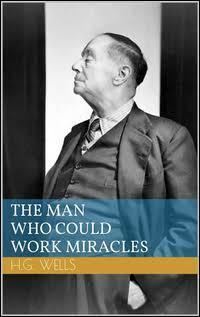Originally published 1898 | ||
 | ||
Adaptations The Man Who Could Work Miracles (1936) Similar H G Wells books, Other books | ||
"The Man Who Could Work Miracles" is a British fantasy–comedy short story by H. G. Wells first published in 1898 in The Illustrated London News.
Contents
The story is an early example of Contemporary fantasy (not yet recognized, at the time, as a specific subgenre). In common with later works falling within this definition, the story places a major fantasy premise (a wizard with enormous, virtually unlimited magic power) not in an exotic semi-Medieval setting but in the drab routine daily life of suburban London, very familiar to Wells himself.
Plot summary
In an English public house, George McWhirter Fotheringay vigorously asserts the impossibility of miracles during an argument. By way of demonstration, Fotheringay commands an oil lamp to flame upside down and it does so, to his own astonishment. His acquaintances think it a trick and quickly dismiss it, but Fotheringay continues to use his new power for other petty deeds.
After magically accomplishing his daily chores as an office clerk, Fotheringay quits early to a park to practise further. He encounters a local constable, who is accidentally injured. In the ensuing altercation, Fotheringay unintentionally sends the policeman to Hades; hours later, Fotheringay relocates him safely to San Francisco.
Unnerved by these miracles, Fotheringay attends local Sunday church services. The clergyman, Mr. Maydig, preaches about unnatural occurrences. Fotheringay is deeply moved, and meets Maydig in his quarters for advice. After a few petty demonstrations, the priest becomes enthusiastic and suggests that Fotheringay should use these abilities to benefit others. That night they walk the town streets, healing illness and vice and improving public works.
Maydig plans to reform the whole world. He suggests that they could disregard their obligations for the next day if Fotheringay could stop the night altogether. Fotheringay agrees and stops the motion of the Earth. His clumsy wording of the wish causes all objects on Earth to be hurled from the surface with great force. Pandemonium ensues, but Fotheringay miraculously ensures his own safety back on the ground. In fact (though he is not aware of the enormity of what he had done) the whole of humanity except for himself had perished in a single instant.
Fotheringay is unable to return the Earth to its prior state. He repents, and wishes that the power be taken from him and the world restored to a time before he had the power. Fotheringay immediately finds himself back in the public house, discussing miracles with his friends as before, without any recollection of subsequent events.
The all-known narrator thus tells the reader that he or she had died "a year ago" (the story was published in 1897) and was then resurrected - but has no recollection of anything special having happened.
Film, TV or theatrical adaptations
In 1936, the story was adapted to a film starring Roland Young as Fotheringay. Wells co-wrote the screenplay with Lajos Bíró.
It was adapted for BBC Radio in 1959 by Dennis Main Wilson and broadcast on New Year's Day. It starred Tony Hancock as Fotheringay.
The story idea was used as the basis for director Terry Jones's 2015 film Absolutely Anything.
